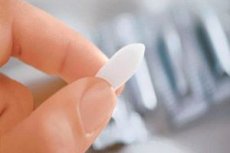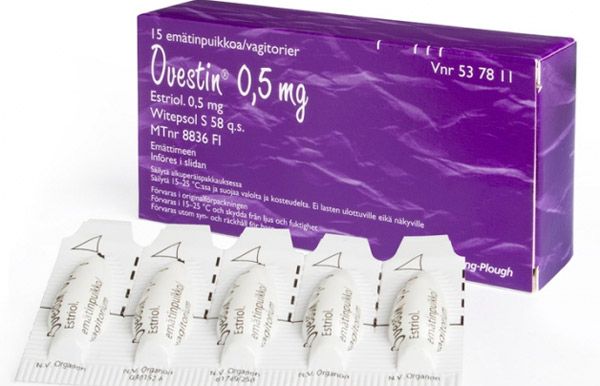Medical expert of the article
New publications
Preparations
Vaginal suppositories during menopause: moisturizing, with estrogens
Last reviewed: 03.07.2025

All iLive content is medically reviewed or fact checked to ensure as much factual accuracy as possible.
We have strict sourcing guidelines and only link to reputable media sites, academic research institutions and, whenever possible, medically peer reviewed studies. Note that the numbers in parentheses ([1], [2], etc.) are clickable links to these studies.
If you feel that any of our content is inaccurate, out-of-date, or otherwise questionable, please select it and press Ctrl + Enter.

During menopause, a woman begins to feel such unpleasant symptoms as irritation, itching, dryness, burning in the vagina. In addition, the vulnerability of this area to infections also increases. In this case, the best solution would be to use special menopause suppositories that help eliminate these symptoms.
Indications of menopausal suppositories
Suppositories are prescribed to eliminate age-related and estrogen-deficient atrophic changes affecting the vaginal mucosa (symptoms include itching and dryness, discomfort in the vagina, pain during intercourse).
Release form
The medicine is available in the form of vaginal suppositories.
Ovestin
Ovestin contains estriol and other components that help normalize vaginal microflora, as well as hormonal balance in this area. The medicine helps maintain vaginal acidity at the required level, preventing the proliferation of pathogenic microorganisms.

Klimaxan
Klimaxan is a natural herbal medicine that helps eliminate disorders that occur as a result of the onset of menopause. Thanks to this drug, it is possible to reduce the severity of climacteric manifestations without affecting the balance of hormones.
Estrogen suppositories during menopause
There are hormonal vaginal suppositories that contain estrogens. They are very effective during menopause. The following preparations are distinguished:
- Estrocad, the active component of which is estriol, which helps restore the thickness of the vaginal mucosa and also enhances its secretory function;
- Ovipol Clio, which also contains estriol. This active component, supplemented by auxiliary elements, helps to remove burning with itching, and in addition, moisturizes the mucous membrane and promotes the production of natural mucus;
- Ortho-Gynest with the help of estriol stimulates the secretion production of the cervix, and not only the vaginal walls. Due to the moisturizing with the help of this medicine, the microflora of the mucous membrane is restored;
- Estriol promotes the production of natural mucus, as a result of which the burning, dryness, and itching that bother women disappear.
Non-hormonal suppositories for menopause
Non-hormonal suppositories containing bioidentical estrogens are an effective alternative to treatment with hormonal agents. These drugs are similar in their chemical structure to beta-estradiols, which are of plant origin. Nowadays, pharmacists produce bioidentical vaginal suppositories containing 3 main estrogens - estriol, as well as estrone with estradiol.
If the patient is contraindicated for treatment with suppositories containing hormones, natural preparations such as Feminela, Vagikal, and Cicatridin should be used.
The properties of suppositories during menopause are discussed using the drug Ovestin as an example.
Pharmacodynamics
Ovestin is an estrogenic drug that acts identically to the natural hormone produced by the female body. It helps restore estrogen levels at the onset of postmenopause and also reduces the manifestation of menopause symptoms.
Very effective in eliminating diseases of the genitourinary system. In case of atrophic processes in the mucous membranes of the lower part of the genitourinary system, estriol helps to strengthen the epithelial layer of the urogenital tract, and also restores healthy microflora with a physiologically necessary pH level inside the vagina. Thanks to this medicine, the epithelial cells in this area become more resistant to inflammatory processes and infections, as a result of which the severity of symptoms such as vaginal itching along with dryness, as well as pain during sexual intercourse, are weakened. In addition, the risk of developing genitourinary infections is reduced, the function of urination is normalized, and incontinence is eliminated.
The difference between estriol and other estrogens is that it has a short duration of action, as it is retained in the nuclei of endometriotic cells only for a short time. It is believed that a single daily dose of estriol does not cause proliferation of endometrial cells. As a result, cyclic use of the progestogen hormone is not necessary, and withdrawal will not cause bleeding. It has also been established that estriol does not increase mammographic density.
Pharmacokinetics
After intravaginal administration of the drug, the optimal required bioavailability is observed at the site of its action. Estriol is absorbed into the systemic bloodstream, manifesting itself as a rapid increase in the blood plasma concentration of the so-called unbound estriol. After administration of the drug, it reaches a peak after 1-2 hours.
Of the plasma proteins, 90% binds to albumin, but almost none binds to globulin (which synthesizes sex hormones), which distinguishes estriol from other estrogens.
During metabolism of the active substance in the process of enterohepatic circulation, it is converted into a conjugated and also unconjugated state. As the final metabolite, estriol is excreted from the body in the urine, being bound. Only a small part (approximately 2%) is excreted in the feces as unbound estriol. The half-life is about 6-9 hours.
After vaginal administration of the drug at a dosage of 0.5 mg, the peak concentration is 100 pg/ml, and the minimum value is about 25 pg/ml. The average value is about 70 pg/ml. After 21 days of daily administration of the drug at a dosage of 0.5 mg, the average value dropped to 40 pg/ml.
Dosing and administration
Suppositories help restore vaginal tissue, and this happens in a fairly short period of time. They should be inserted vaginally in the evenings (before bedtime). The procedure should be carried out for 1-2 weeks, and after this course, continue to put 1 suppository 2-3 times a week.
 [ 13 ]
[ 13 ]
Contraindications
Ovestin is contraindicated:
- during pregnancy, and also in case of intolerance to the components of the drug;
- it also cannot be prescribed for breast cancer (if there is a history of it, or if the woman currently has it, or if it is suspected);
- in addition, in case of malignant tumors of estrogen-dependent nature (often in case of endometrial cancer or suspicion of it);
- in case of vaginal bleeding of unclear origin;
- if there is a history of acute thrombus occlusion (venous or arterial type);
- in acute liver diseases or changes in liver tests;
- in porphyria disease.
Vagikal is prohibited for use in case of hypersensitivity to the components of the drug.
Side effects of menopausal suppositories
Like any locally administered medication, suppositories for menopause can cause an allergic reaction due to intolerance to the components of the drug, such as itching and irritation in the vagina.
Ovestin can cause side effects such as pain and discomfort in the mammary glands, as well as nausea. In rare cases, headaches appear, and blood pressure increases.
Interactions with other drugs
There have been no registered cases of negative interactions between Ovestin suppositories and other drugs.
Estrogen metabolism processes may be accelerated by combination with substances that induce enzymes that participate in drug metabolism. This is especially true for cytochrome P450 isoenzymes, such as antiepileptics (such as phenytoin, as well as phenobarbital with carbamazepine), as well as antimicrobials (such as nevirapine and rifampicin, as well as efavirenz with rifabutin).
When steroid hormones are combined with nelfinavir and ritonavir, the inducing effect of the latter is enhanced.
Herbal medicines (containing St. John's wort) are capable of inducing estrogen metabolism processes.
Increased metabolism of estrogens may reduce their clinical effectiveness.
Estriol increases the properties of hypolipidemic drugs. In addition, it reduces the effects of anticoagulants, diuretics, antidiabetic, hypotensive drugs, and male sex hormones.
General anesthetics, tranquilizers, narcotic analgesics, certain hypotensive drugs, and ethanol reduce the medicinal effect of Ovestin.
Thyroid hormone preparations, as well as folic acid, enhance the therapeutic properties of estriol.
Attention!
To simplify the perception of information, this instruction for use of the drug "Vaginal suppositories during menopause: moisturizing, with estrogens" translated and presented in a special form on the basis of the official instructions for medical use of the drug. Before use read the annotation that came directly to medicines.
Description provided for informational purposes and is not a guide to self-healing. The need for this drug, the purpose of the treatment regimen, methods and dose of the drug is determined solely by the attending physician. Self-medication is dangerous for your health.

